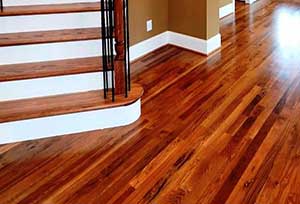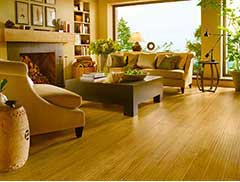 We’ve rounded up a list of the 10 most common types of hardwood floors here in the US. The United States happens to be blessed with a vast natural resource of various wood species. There’s hundreds of types. It so happens that the most common types of trees are ideal for many uses including home construction, flooring, furniture & crafts. All of the types of hardwood on our list are grown right here in the good old US of A. The only exception on our list is bamboo, which is technically not a hardwood but a grass and is mostly imported from China.
We’ve rounded up a list of the 10 most common types of hardwood floors here in the US. The United States happens to be blessed with a vast natural resource of various wood species. There’s hundreds of types. It so happens that the most common types of trees are ideal for many uses including home construction, flooring, furniture & crafts. All of the types of hardwood on our list are grown right here in the good old US of A. The only exception on our list is bamboo, which is technically not a hardwood but a grass and is mostly imported from China.
Our list of 10 types of wood is in order starting with the most popular – Oak. Following is Maple and Hickory. These are the top 3. The next 2, American Cherry & Walnut are also quite popular. The next 4 hardwoods on our list have a lower demand and buying options may be less. That is not to say that they are very uncommon or less suited for your purpose. Just that the vast majority of floors in the US are made with one of the top 5 on our list. We put bamboo last only because it’s technically not a hardwood. It’s gaining increasing popularity and has become widely available.
 1. Oak Wood Floors
1. Oak Wood Floors
price: affordable
Janka hardness rating: Red Oak 1290, White Oak 1360
Oak is by far the most common type of wood used for wood floors in the US, especially Red Oak. It grows abundantly in the US. Thus Oak is an affordable hardwood. There are several reasons why Oak flooring is ideal. To simplify the process of selecting a type of wood, we first recommend Oak to our customers. We suggest Oak as the best choice for all practical purposes. Here’s why:
Aside from being one of the most affordable types of wood, Oak is also very durable. With a hardness rating of 1290 Oak stands up well to traffic. Hardness is related to how well a wood resists dents & scratches; and also how much the wood will expand and contract under temperature and humidity changes.
Oak is not actually the hardest type of wood. There’s other much harder types such as Brazilian Walnut which has a hardness rating of 3680. However this is not always ideal. Very hard wood is much harder to work with for cutting and nailing. Thus the wood itself and flooring installation cost is higher. Sanding and refinishing is also more costly. Such hard wood does not absorb stain as well. Color changing by stain may not be an option. A medium hard wood like Oak is ideal for several reasons. Oaks’ hardness rating of 1290 makes it:
- more affordable as it is easier to work with
- ideal for periodic sanding & refinishing – floors can be easily restored to look new again
- ideal for applying stain & easy to change the color – there’s many stain colors available from light to dark. Oak can be purchased prefinished or unfinished where finishing is applied on site.
- resistant enough to expansion and contraction which causes gaps and warping (good dimensional stability)
- resistant enough to dents and scratches (like any wood floor care must be taken)
Also, Oak’s obvious grain pattern helps to hide dents and scratches. For these reasons Oak is ideal for high traffic areas and homes with pets. It’s classic and traditional look goes well with just about any style of decor and furniture. For all practical purposes we consider oak flooring to be the gold standard. The only reason we can give that one may not want Oak is if you prefer something with a less noticeable grain pattern.
There’s two types of Oak flooring available – Red Oak and White Oak. They differ only slightly in color, graining and hardness. Otherwise both have the same qualities. Red Oak has more of a reddish hue with White Oak having a range of golden to brown to gray tones. Some White Oak has a more subtle grain pattern. As mentioned Red Oak is most common, though both are widely available. More about Oak flooring…
 2. Maple Wood Floors
2. Maple Wood Floors
price: generally affordable but more costly than Oak
Janka hardness rating: 700-1450
Maple is a common wood species growing in the Northern US and Canada. There are many species of maple and they vary in grade. Because of this Maple wood flooring tends to vary alot in terms of price, quality, hardness & grain pattern.
Maple tends to have a swirling grain pattern. With some Maple wood flooring the grain pattern is prominent. Then there’s some where it is barely noticeable and the planks are very consistent in color. This is an option if you prefer a more uniform look. And it’s ideal for a natural clear finish. With Maple you could have either the uniform look or the colorful look.
Maple flooring is often harder than Oak with a hardness rating of 1450. The harder maple is used in bowling alleys as it’s very resistant to dents & scratches. On the other hand it’s hardness makes it less absorbant of stains. Stain tends to blotch on Maple unless the wood is first prepared with conditioner. This is a style that some prefer and which we offer. Stained Maple is available in prefinished planks so you’ll know exactly how it looks before installation.
Maple’s natural color is generally light hues of beige, tan or grey. It’s often used in modern & contemporary settings.
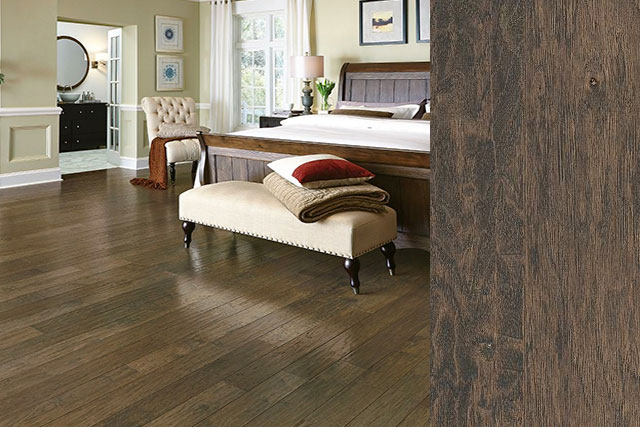 3. Hickory Wood Floors
3. Hickory Wood Floors
price: Slightly above average, more expensive than Oak
Janka hardness rating: 1820
Hickory is common for wood floors in log homes and rustic settings, though today it’s used in all kinds of settings. It is popularized by it’s strong knotted grain pattern and color variance. With it’s variable texture it’s more common in wide planks. Small planks can result in a floor that looks very busy. Colors can range on a single board from beige to brown to red.
Hickory flooring is very hard with an 1820 rating. It’s one of the hardest US grown types of hardwood flooring. Thus it’s very durable and resistant to dents & scratches. Hickory wood floors are ideal for high traffic areas and homes with pets. It can last a lifetime with proper care and generally requires relatively low maintenance. The need to refinish will likely be less often than Oak.
While it’s hardness has these advantages, the downside is that the costs will be higher for installation, sanding & refinishing. Harder types of wood require more labor and skill for these jobs. That includes staining as well. But because Hickory is naturally colorful, staining isn’t really necessary. A natural clear finish is ideal.
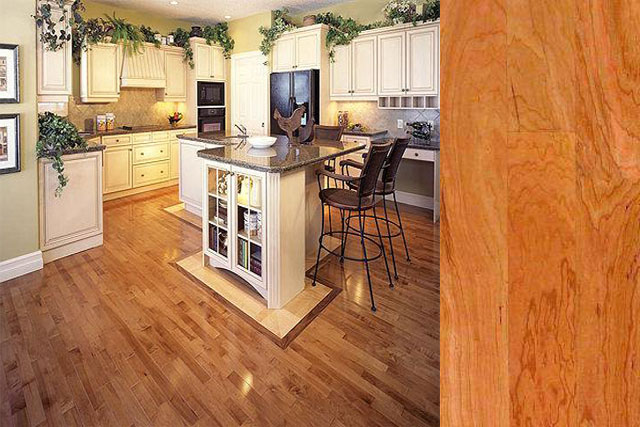 4. American Cherry Wood Floors
4. American Cherry Wood Floors
price: expensive
Janka hardness rating: 950
The American Cherry tree grown in the northern US is another common domestic species. The tree makes cherry fruits and is also harvested for wood floors.
Cherry wood floors are more expensive. Though it’s a soft wood, cherry is harder to work with. Softer wood means it is more susceptible to dents and scratches. It’s more suited for low traffic areas like bedrooms. It does however have good dimensional stability. This means shrinkage & expansion caused by temperature & humidity is not much of an issue.
The allure of a cherry wood floor is it’s beautiful natural color and distinctive grain pattern. Cherry has a deep reddish brown color. The wood surface is sensitive to light which causes it to darken. This happens mostly in the first 6 months. It’s advisable to wait at least that long before placing any area rugs. All types of wood floors however are photosensitive to varying degrees – after time the color changes by exposure to light. Some wood floors get lighter and some darker. So no matter what type of flooring you choose, be careful with area rugs.
Cherry flooring installation is often done with wide planks, 5-8 inches. This is to showcase the gorgeous grain pattern. And cherry flooring is usually not stained. The natural color is left as is with a clear coat finish.
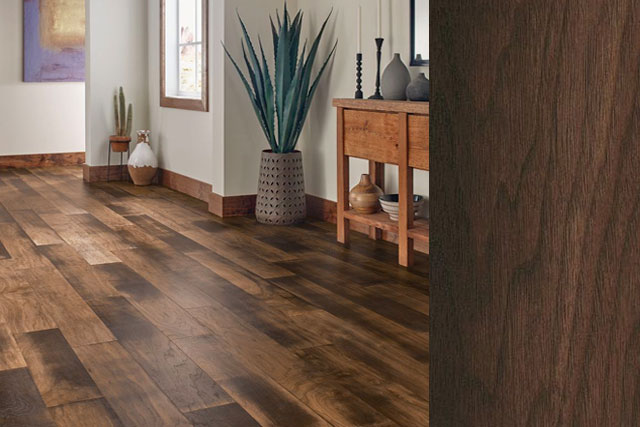 5. American Walnut (aka Black Walnut) Wood Floors
5. American Walnut (aka Black Walnut) Wood Floors
price: expensive
Janka hardness rating: 1010
Grown in the central and eastern US, Walnut is another favorite for hardwood floors. And it’s delicious nuts are a favorite for snacks. American Walnut is not to be confused with Brazilian Walnut, which is a much harder type of wood.
Like Cherry, Walnut is also an expensive, soft hardwood. Though these types of wood are softer and more suited for low traffic, their elegant beauty is what makes them popular. Walnut wood has wide color and grain variation depending on the part of the tree. Colors vary from light to dark brown. Floor planks usually vary only slightly giving a consistent look.
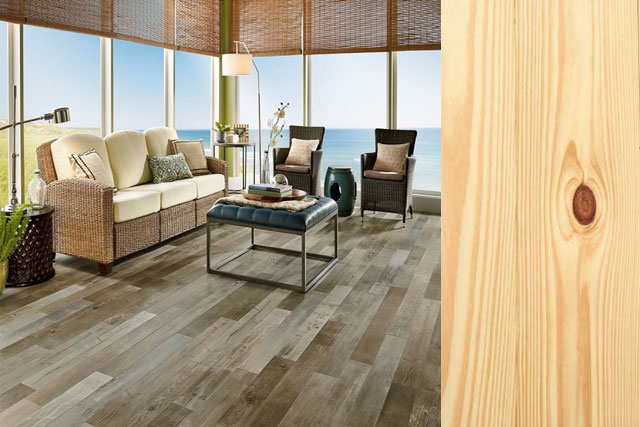 6. Pine (aka Eastern White Pine or Southern Yellow Pine)
6. Pine (aka Eastern White Pine or Southern Yellow Pine)
price: average
Janka hardness rating: 690-870
Pine is a sustainable type of wood as it grows rapidly and very commonly in the US and Canada. There’s various Pine species and hardness will vary depending on the species as well as the part of the tree it’s from. The most common type is Eastern White Pine from the the northeastern states. Southern Yellow Pine is a harder species from the Southern US. The hardest Pine is Heart Pine which comes from the center of the tree and has a Janka Hardness rating of 1225.
Most of the Pine flooring which is available is the Eastern White or Southern Yellow which is much softer. You have to be more careful as it dents & scratches more easily. It has less dimensional stability & requires more skill & labor to refinish. Softer types of wood such as Pine are more common in older homes from back when wood mills were less capable of dealing with harder wood. The advantage of Pine is it’s traditional look with gorgeous grain & characteristic knots. And it’s appearance gets even better with age. The color of Pine varies from yellowish white to yellow, orange & brown.
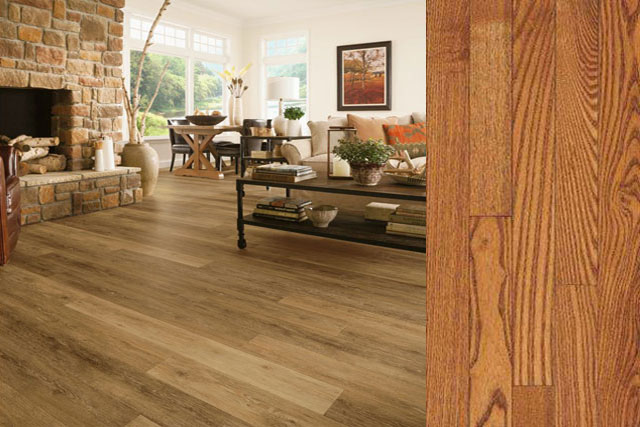 7. Ash Wood Floors (good alternative to Oak)
7. Ash Wood Floors (good alternative to Oak)
price: lower than average
Janka hardness rating: 1320
Ash is another tree which grows widely across the US. It’s less expensive than Oak but has some similarities which make it a good alternative. It’s medium hardness is like oak, making it good for traffic. It’s good to work with for installation, staining & refinishing. It also has a unique grain which is comparable to Oak. Ash wood floors are known particularly for light color. Colors range in light tones of white, yellow, tan & brown.
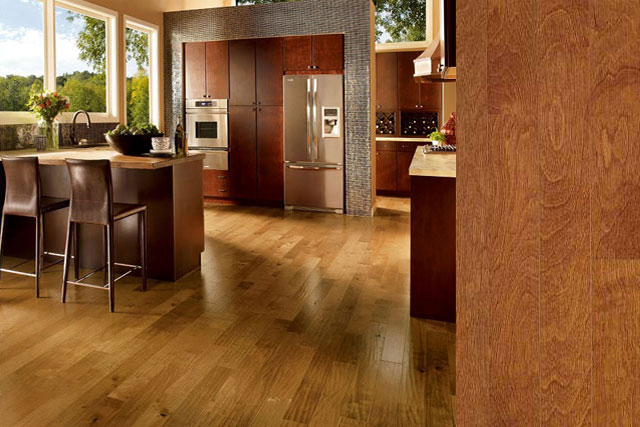 8. Birch Wood Floors
8. Birch Wood Floors
price: lower than average
Janka hardness rating: 910-1470
The Birch tree gives a great flavor and is also used for floors. It grows abundantly in the US and is affordable. It looks similar to Maple in color & grain while it’s less expensive. It also has a fine, often indistinct grain. Like Maple it also tends to blotch when stained. So it’s not usually finished on site but prefinished.
It also has a similar range of hardness depending on the species and part of the tree. You’ll find a few types of Birch wood floors, namely Paper, Yellow, Sweet & Red, from soft to hard with Red Birch – a heart wood, the hardest type. Most Birch available is Yellow, a soft wood – suitable for low traffic, less resistant to damage & with less dimensional stability. Yellow Birch has white & yellow tones. Red Birch has gold, red & brown tones.
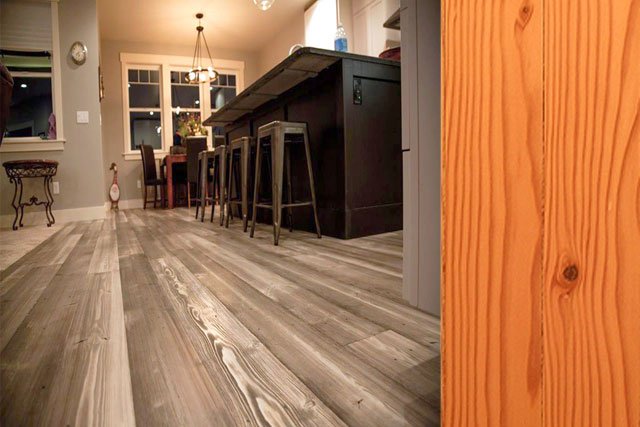 9. Douglas Fir Wood Floors
9. Douglas Fir Wood Floors
price: lower than average
Janka hardness rating: 660
Douglas Fir grows mostly along the US West Coast. It’s another of the soft types of wood more common in old in homes. Douglas Fir is one of the softest woods used for wood floors with a hardness rating of only 660. This means that it’s only suited for low traffic as it’s easily damaged and much care must be taken.
The reasons for using Douglas Fir are for one it’s low price. And it’s look is appealing for those who prefer a floor with a uniform texture. Floor boards come with a very consistent color and subtle grain giving the uniform look. Douglas Fir is available in tones of gold, orange, red and brown. The color darkens with age. Douglas Fir flooring is rarely available prefinished but usually finished on site.
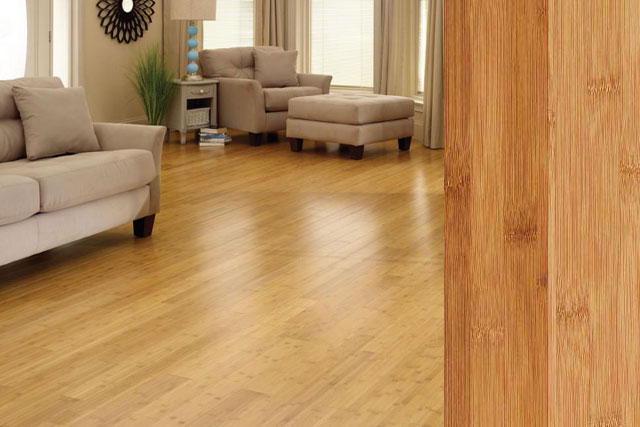 10. Bamboo Flooring
10. Bamboo Flooring
price: varies by quality
Janka hardness rating: most is 1200-1400, but there’s a wide range.
Since around the year 2000 Bamboo flooring has increasingly emerged as a competitor for hardwood. Bamboo is technically a type of grass, not a hardwood. Compressed strips of Bamboo are manufactured into floor planks.
Bamboo is mostly produced in China. Some species grow as much as 3 feet in a day. It is touted as a “green” renewable resource because it grows so amazingly fast. Some environmentalists though assert that it’s renewability is offset by it’s having to be shipped from China.
Either way, Bamboo is in abundant supply. There’s over 1,000 species. Unlike hardwood, it has only recently emerged as a flooring material. But today there is a vast selection of Bamboo flooring available. It comes in a wide variety of colors, styles and finishes. It has become popularized by it’s stylish look.
Due to the large variety of species and manufacturing standards Bamboo flooring varies widely in quality. One must beware of cheap Bamboo products which are generally not very durable. When shopping for Bamboo be careful to look for information on warranties, hardness ratings & finishes.
Various species can be soft as Pine or harder than Maple. Much of the available Bamboo is of good quality and has a hardness rating of 1200-1400, comparable to oak. Strand woven Bamboo is the most durable, harder than Red Oak.
Bamboo is not as easy to stain or refinish as Oak. It is best to install prefinished Bamboo flooring. In general Bamboo floors can be refinished only two or three times. (More about Bamboo flooring)
There are so many options to consider when shopping for new flooring that it can seem overwhelming. This covers the main types of domestic woods used in US flooring. We install all types of floors and find that hardwood floors are the most popular here in New York City. And amongst all the types of hardwood, Red Oak is the most popular with all of it’s fine qualities. We hope this has helped.

